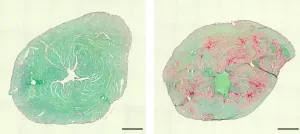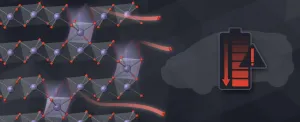(Press-News.org) LAWRENCE -- The United States has the highest population of incarcerated citizens among developed nations. Every year, roughly 2 million women, the majority held in jails, leave incarceration. The COVID-19 pandemic hit jails and correctional facilities harder than almost any other societal setting. Many of the people leaving incarceration are returning to communities that were also disproportionately affected by the pandemic, yet many people in that population have expressed hesitancy to receive a COVID-19 vaccine.
New research from the University of Kansas found high rates of vaccine hesitancy among women transitioning from incarceration, due to a multitude of reasons, including low health literacy, lack of trust in authorities, and misconceptions about COVID-19 and the vaccine. The COVID-19 pandemic has further affected these women who already had low compliance with cancer screening and prevention recommendations, and they had limited knowledge about topics such as women's health. An online app developed by KU researchers to boost health literacy among this population may be an efficient and cost-effective way to address multiple health topics.
Vaccine hesitancy among women leaving incarceration
Researchers at KU and KU Medical Center published a study in the journal Public Health Nursing about vaccine hesitancy among the target population. It was co-written by Mugur Geana, associate professor of journalism & mass communications and director of KU's Center for Excellence in Health Communications to Underserved Populations; and Sherri Anderson and Megha Ramaswamy, Department of Population Health at KU School of Medicine. Researchers interviewed 25 women recently released from jail between March 5 and 25. The women were part of a larger cohort participating in a National Institutes of Health-funded study on health literacy among incarcerated women, of which Ramaswamy is principal investigator.
While the vaccine was not yet widely available at the time of interviews, the results showed 52% of respondents said they were definitely not willing to receive a vaccine. Only 20% said "yes, they would vaccinate." In addition to those refusing to vaccinate, various degrees of hesitancy were found: 12% said yes, they would vaccinate, but only if they were required because of work or family reasons, while 8% said "maybe, but not right now." Additionally, 4% of respondents said "they would not refuse it if offered but would not voluntarily pursue it" or "yes, with serious concerns." The 76% total hesitancy was attributed to a number of factors such as mistrust in government or the pharmaceutical industry, not having enough information on how vaccines work, listening to conspiracy theories, returning to anti-vaccination communities and others, the authors said.
"We tried to better understand their perceptions and knowledge about COVID-19 and vaccines," Geana said. "We expected to find some hesitancy among these women, but not at these levels. To a certain extent, some of those factors for hesitancy can be addressed or corrected through better education and information provided by people they trust. They can also be addressed by health literacy interventions like those we are developing."
The authors argue the results indicate not only is health education needed for the studied population, but that assumptions should not be made about why people are hesitant to receive a vaccine. There are legitimate reasons, such as health factors preventing some from being able to take vaccines; health providers, communicators and others should not rush to judgment about those who are hesitant. While there is not much preliminary data available about pandemics and women transitioning from incarceration, the results do align with previous research findings that low-income groups and women are two of the most significant predictors of COVID-19 vaccine uncertainty and refusal.
"Probably the No. 1 lesson from this study is that there is an immediate need for intervention about both COVID-19 testing as well as the COVID-19 vaccine for underserved populations," Geana said.
Online intervention to improve women's health literacy after incarceration
Researchers also recently published a study sharing the results of testing of an online health intervention designed to boost health literacy on topics deemed important to women leaving incarceration. The study focuses on the development and pilot testing of an online intervention specifically designed to boost women's health knowledge among the aforementioned underserved population. Published in the Journal of Health Care for the Poor and Underserved, the study was written by Geana and a team of researchers directed by Ramaswamy from the KU School of Medicine.
The researchers partnered with an advisory board, including women transitioning from incarceration, to determine what health topics were important to this audience and the most appropriate format for information delivery. CEHCUP developed the website structure and programming, and it produced the multimedia content for health modules on the topics of sexually transmitted infections, cervical cancer, reproductive planning and breast health. The KU School of Medicine team tested the effectiveness of the online resource, called the SHE WOMEN mHealth Intervention. The project was funded by the National Institutes of Health.
"The way health information for this population is delivered is mostly by in-person sessions during incarceration. A doctor or nurse talks with them for a half-hour or so, and they move on," Geana said. "We decided to move away from that model and use multiple sessions that transition seamlessly and where users can start with any module they like, when they feel they are ready to learn about their health. The web app was designed to collect varied data so we could use it as a research platform to capture usability metrics as well as testing their retention and understanding of the provided information. The research team was also able to interact with the participants individually, if needed, through the web app."
The results showed their knowledge and health literacy improved, and interactions with participants revealed high satisfaction with how the information was delivered. Participants stated they appreciated seeing videos featuring people that reflected their communities, being able to ask questions, receive text messages from researchers reminding them about participation and getting usable information on topics that were central to their lives and health.
The encouraging results show that such an online health literacy intervention can be a successful way to boost knowledge of vulnerable populations in an understandable way, the researchers said, and they plan to study how to make similar programs more widely available and affordable to similar populations across the country. To that end, the researchers also proposed 10 steps for those looking to develop similar programs for boosting health literacy in underserved populations. Chief among them was to form an advisory board of members from the target audience to identify relevant topics, provide feedback on technology, user experience and content development.
"It doesn't matter how much a researcher interacts with an underserved population, we can never have the same experience," Geana said. "The only way to cater to them effectively is to have them as part of the research team."
INFORMATION:
Syracuse, N.Y. - A study of nearly 550 adults with intellectual and developmental disabilities receiving residential services in New York City found that age, larger residential settings, Down syndrome and chronic kidney disease were the most common risk factors for COVID-19 diagnosis, and heart disease was most associated with COVID-19 deaths.
The study, "Risk Factors Associated With COVID-19 Outcomes Among People With Intellectual and Developmental Disabilities Receiving Residential Services," was published June 8 by JAMA Network Open and provided the first evidence of the risk factors leading to COVID-19 diagnosis and death among people with IDD who receive residential services.
The study's findings suggest that ...
Fully occupied intensive care units (ICUs). Physically and mentally exhausted health workers. Chaotically overcrowded hospitals. These and similar problems posed by the COVID-19 pandemic in Brazil have created ideal conditions for the emergence of Candida auris, a microorganism some are calling a "superfungus" because of the speed with which it has developed drug resistance.
The first two cases were confirmed in December 2020 at a hospital in Salvador (state of Bahia, Northeast Brazil), and are described in the Journal of Fungi by a group of researchers led by Arnaldo Colombo, head of the Special Mycology Laboratory at the Federal University of São Paulo (UNIFESP). The study was supported by São Paulo Research Foundation - FAPESP.
"Nine other C. auris patients ...
TROY, N.Y. -- The future of quantum computing may depend on the further development and understanding of semiconductor materials known as transition metal dichalcogenides (TMDCs). These atomically thin materials develop unique and useful electrical, mechanical, and optical properties when they are manipulated by pressure, light, or temperature.
In research published today in Nature Communications, engineers from Rensselaer Polytechnic Institute demonstrated how, when the TMDC materials they make are stacked in a particular geometry, the interaction that occurs between particles gives researchers more control over the devices' properties. Specifically, the interaction between ...
A discovery from researchers at the University of Illinois Chicago may lead to new treatments for individuals who suffer from alcohol use disorder and depression.
The study, "Transcriptomics identifies STAT3 as a key regulator of hippocampal gene expression and anhedonia during withdrawal from chronic alcohol exposure," is published in the journal Translational Psychiatry by researchers at UIC's Center for Alcohol Research in Epigenetics.
"During withdrawal from long-term alcohol use, people often suffer from depression, which may cause them to start drinking again as a way to self-medicate. If we ...
The spin of the Milky Way's galactic bar, which is made up of billions of clustered stars, has slowed by about a quarter since its formation, according to a new study by researchers at University College London (UCL) and the University of Oxford.
For 30 years, astrophysicists have predicted such a slowdown, but this is the first time it has been measured.
The researchers say it gives a new type of insight into the nature of dark matter, which acts like a counterweight slowing the spin.
In the study, published in the Monthly Notices of the Royal Astronomical Society, researchers analysed Gaia space telescope observations of a large group of stars, the Hercules stream, which are in resonance with the bar - that is, they revolve around the galaxy ...
An international team of researchers led by the University of Bonn (Germany) has identified the cause of a rare, severe muscle disease. According to these findings, a single spontaneously occurring mutation results in the muscle cells no longer being able to correctly break down defective proteins. As a result, the cells perish. The condition causes severe heart failure in children, accompanied by skeletal and respiratory muscle damage. Those affected rarely live beyond the age of 20. The study also highlights experimental approaches for potential treatment. Whether this hope will be fulfilled, however, will only become clear in a few years. The results are published in the journal Nature ...
A funny thing happened on the way to discovering how zinc impacts kidney stones - two different theories emerged, each contradicting the other. One: Zinc stops the growth of the calcium oxalate crystals that make up the stones; and two: It alters the surfaces of crystals which encourages further growth. Now it can be told - both theories are correct as reported in the America Chemical Society journal Crystal Growth & Design by Jeffrey Rimer, Abraham E. Dukler Professor of Chemical and Biomolecular Engineering at the University of Houston, who conducted the first study to offer some resolution to the differing hypotheses.
"What we see with zinc is something ...
Our ability to confront global crises, from pandemics to climate change, depends on how we interact and share information.
Social media and other forms of communication technology restructure these interactions in ways that have consequences. Unfortunately, we have little insight into whether these changes will bring about a healthy, sustainable and equitable world. As a result, researchers now say that the study of collective behavior must rise to a "crisis discipline," just like medicine, conservation and climate science have done, according to a new paper published June 14 in the Proceedings of the National Academy of ...
(Santa Barbara, Calif.) -- Scientists at UC Santa Barbara, University of Southern California (USC), and the biotechnology company Regenerative Patch Technologies LLC (RPT) have reported new methodology for preservation of RPT's stem cell-based therapy for age-related macular degeneration (AMD).
The new research, recently published in Scientific Reports, optimizes the conditions to cryopreserve, or freeze, an implant consisting of a single layer of ocular cells generated from human embryonic stem cells supported by a flexible scaffold about 3x6 mm in size. ...
When lithium ions flow in and out of a battery electrode during charging and discharging, a tiny bit of oxygen seeps out and the battery's voltage - a measure of how much energy it delivers - fades an equally tiny bit. The losses mount over time, and can eventually sap the battery's energy storage capacity by 10-15%.
Now researchers have measured this super-slow process with unprecedented detail, showing how the holes, or vacancies, left by escaping oxygen atoms change the electrode's structure and chemistry and gradually reduce how much energy it can store.
The results contradict some of the assumptions scientists had made about this process and could suggest new ways of engineering electrodes to prevent it.
The research team from the Department of Energy's ...




